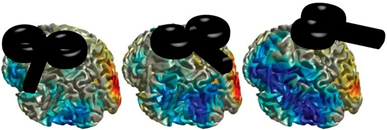This post is also available in Dutch.
The past 30 years has seen an explosion in brain stimulation used in research. Now it’s easier for people to get their own devices. Should this be regulated?
Image source: Marshall T., et al., 2015, J Neurosci. 35(4): 1638-1647
(The Donders Institute will be running an advanced brain stimulation “Toolkit” course from September 10th-13th 2018. Researchers interested in state-of-the art techniques are encouraged to participate.)
Brain stimulation in research and clinical settings
In 1985, scientists in Sheffield, UK showed that powerful magnetic fields generated by transcranial magnetic stimulation (TMS) could trigger electrical responses in the brain. It was a major advance for the medical and research communities because, unlike traditional electrical stimulation (which used high currents), it did not hurt.
In 2000, using a technique known as transcranial direct current stimulation (TDCS), scientists in Göttingen, Germany showed that very low electrical currents could slightly raise or lower the “excitability” of the brain, while not causing any discomfort.
Medical and research communities were excited by both TMS and TDCS because they opened the potential to treat neurological diseases, as well as providing tools to test how the brain works in a cause-and-effect way. (See, for example, this video from London, showing how stimulation can alter the ability of the brain to produce speech.) Subsequent research and clinical findings, however, produced mixed results, as there is a lot of variability in the effects.
Fast-forward to 2018 and we find that TMS and TDCS can be placed in the hands of an individual in his or her home. Critical questions are now arising about allowing people to tinker with their own brain’s activity, especially when scientists have not yet worked out why TMS and TDCS produce variable effects across individual people.
Home-based uses of non-invasive brain stimulation
TMS can now be used to treat migraines in a person’s own home. The idea is simple: if you are someone who experiences a visual “aura” before migraine onset, place the TMS device over the visual area of the brain and zap it! Fortunately, this device cannot be purchased without a physician’s prescription.
TDCS, however, is generally unregulated. Safety limits are imposed on the currents, but the application can be the choice of the user. Research has shown some positive results of TDCS for improved performance during training in cognitive tasks, but again results are mixed across individuals. Nevertheless, the gaming community has taken particular notice in TDCS.
Using brain stimulation for performance enhancement?
Perhaps the most pressing conversation needs to be with regards to sports and competitions (including gaming). Is it cheating to give your brain a boost? One study suggests that increasing the excitability of the leg motor region of your brain with TDCS may also give you a boost of endurance, certainly putting brain stimulation in the realm of doping. But it becomes difficult to regulate this if it is not yet proven to be consistent across individuals.
Hold a TMS coil over the motor area of your brain and you will trigger muscle twitches – this is well established. But for other regions of the brain, we still do not know how far the current spreads and what the effect of the individual’s health, age, or the shape of their brain’s folding patterns means for the effects. Donders researchers and colleagues are hard at work trying to get a handle on these topics, hoping to help shape the future applications of brain stimulation.
(The Donders Institute will be running an advanced brain stimulation “Toolkit” course from September 10th-13th 2018. Researchers interested in state-of-the art techniques are encouraged to participate.)
Written by Ian Cameron, PhD, a Senior Researcher who examines cognition and eye movement control using TMS and functional magnetic resonance imaging (fMRI). Edited by Marisha.
